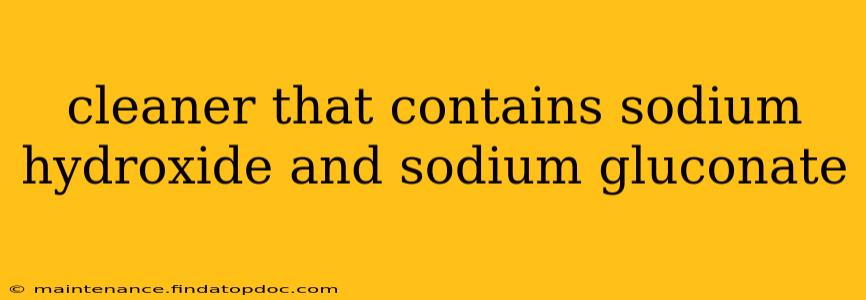Understanding Cleaners Containing Sodium Hydroxide and Sodium Gluconate
Sodium hydroxide (NaOH), also known as lye or caustic soda, and sodium gluconate are frequently found together in cleaning products, particularly those designed for heavy-duty cleaning or industrial applications. This combination leverages the strengths of each compound to create a more effective and, in some cases, gentler cleaning solution. Let's delve into the roles of each component and explore the benefits and potential drawbacks of this formulation.
What is Sodium Hydroxide (NaOH)?
Sodium hydroxide is a highly alkaline, corrosive chemical. Its strong alkalinity makes it a powerful degreaser and effective at dissolving organic matter, making it ideal for cleaning heavily soiled surfaces. However, its corrosive nature necessitates careful handling and appropriate safety precautions. It's crucial to always follow the manufacturer's instructions and wear protective gear when using products containing sodium hydroxide.
What is Sodium Gluconate?
Sodium gluconate is a chelating agent, meaning it binds to metal ions in water, preventing them from reacting with other substances. In cleaning products, this is particularly beneficial because it prevents the formation of soap scum and mineral deposits. Furthermore, it can enhance the effectiveness of other cleaning agents, making the overall cleaning process more efficient. It's also considered relatively environmentally friendly compared to other chelating agents.
Why are Sodium Hydroxide and Sodium Gluconate Used Together?
The combination of sodium hydroxide and sodium gluconate offers several advantages:
- Enhanced Cleaning Power: Sodium hydroxide provides the strong cleaning action, effectively removing grease, grime, and other stubborn soils.
- Improved Cleaning Efficiency: Sodium gluconate helps prevent the formation of mineral deposits and soap scum, preventing them from interfering with the cleaning process. This leads to a cleaner, more thorough clean.
- Potential for Reduced Corrosion: While sodium hydroxide is corrosive, the inclusion of sodium gluconate can help to mitigate some of this corrosiveness, particularly when used on certain surfaces. It helps to control the aggressive nature of the hydroxide.
- Better Water Softening: Sodium gluconate acts as a water softener, reducing the hardness of water and improving the overall performance of the cleaning solution. This is particularly beneficial in areas with hard water.
What are the Applications of Cleaners Containing Both?
Cleaners incorporating both sodium hydroxide and sodium gluconate find use in a variety of applications, including:
- Industrial Cleaning: Heavy-duty cleaning of industrial equipment, machinery, and facilities.
- Food Processing: Cleaning and sanitizing food processing equipment (although careful consideration of food contact regulations is essential).
- Automotive Cleaning: Degreasing and cleaning automotive parts and engines.
- Plumbing Maintenance: Clearing clogged drains (although professional help is always recommended for serious blockages).
What Safety Precautions Should Be Taken?
Due to the presence of sodium hydroxide, always exercise caution when handling cleaners containing this combination:
- Wear protective gloves and eye protection.
- Ensure adequate ventilation.
- Avoid skin contact.
- Keep out of reach of children.
- Follow the manufacturer's instructions carefully.
- In case of accidental contact, flush the affected area with plenty of water and seek medical advice if necessary.
Are there Alternatives to Cleaners Containing Sodium Hydroxide?
Yes, numerous alternatives exist, depending on the specific cleaning task. These may include cleaners based on less aggressive alkaline agents, enzymatic cleaners, or even simpler solutions like soap and water. The best alternative will depend on the type of dirt or grime being removed and the surface being cleaned.
How do I dispose of cleaners containing sodium hydroxide and sodium gluconate?
Always follow local regulations for hazardous waste disposal. Never pour these cleaners down the drain.
This information aims to provide a comprehensive understanding of cleaners containing sodium hydroxide and sodium gluconate. Remember, always prioritize safety and follow manufacturer guidelines when handling any cleaning product.
